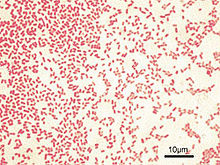- Gram-negative bacteria
-
Gram-negative bacteria are bacteria that do not retain crystal violet dye in the Gram staining protocol.[1] In a Gram stain test, a counterstain (commonly safranin) is added after the crystal violet, coloring all Gram-negative bacteria with a red or pink color. The test itself is useful in classifying two distinct types of bacteria based on the structural differences of their bacterial cell walls. Gram-positive bacteria will retain the crystal violet dye when washed in a decolorizing solution.
The pathogenic capability of Gram-negative bacteria is often associated with certain components of Gram-negative cell walls, in particular, the lipopolysaccharide layer (also known as LPS or endotoxin layer).[1] In humans, LPS triggers an innate immune response characterized by cytokine production and immune system activation. Inflammation is a common result of cytokine (from the Greek cyto, cell and kinesis, movement) production, which can also produce host toxicity.
Contents
Characteristics
The following characteristics are displayed by Gram-negative bacteria:
- Cytoplasmic membrane
- Thin peptidoglycan layer (which is much thinner than in Gram-positive bacteria)
- Outer membrane containing lipopolysaccharide (LPS, which consists of lipid A, core polysaccharide, and O antigen) outside the peptidoglycan layer
- Porins exist in the outer membrane, which act like pores for particular molecules
- There is a space between the layers of peptidoglycan and the secondary cell membrane called the periplasmic space
- The S-layer is directly attached to the outer membrane, rather than the peptidoglycan
- If present, flagella have four supporting rings instead of two
- No teichoic acids or lipoteichoic acids are present
- Lipoproteins are attached to the polysaccharide backbone.
- Most of them contain Braun's lipoprotein, which serves as a link between the outer membrane and the peptidoglycan chain by a covalent bound
- Most do not sporulate (Coxiella burnetii, which produces spore-like structures, is a notable exception)
Classification
Along with cell shape, Gram staining is a rapid diagnostic tool and used to be used to group species at the subdivision of Bacteria.
In fact, historically the kindgom Monera was divided into four divisions based on Gram staining: Firmacutes [sic] (+), Gracillicutes (-), Mollicutes (0) and Mendocutes (var.).[2] Since 1987, the monophyly of the Gram-negative bacteria has been disproven with molecular studies.[3] However some authors, such as Cavalier-Smith still treat them as a monophyletic clade and refer to the group as subkindgom "Negibacteria".[4]
Example species
The proteobacteria are a major group of Gram-negative bacteria, including Escherichia coli (E. coli), Salmonella, Shigella, and other Enterobacteriaceae, Pseudomonas, Moraxella, Helicobacter, Stenotrophomonas, Bdellovibrio, acetic acid bacteria, Legionella and numerous others. Other notable groups of Gram-negative bacteria include the cyanobacteria, spirochaetes, green sulfur and green non-sulfur bacteria.
Medically relevant Gram-negative cocci include three organisms, which cause a sexually transmitted disease (Neisseria gonorrhoeae), a meningitis (Neisseria meningitidis), and respiratory symptoms (Moraxella catarrhalis).
Medically relevant Gram-negative bacilli include a multitude of species. Some of them primarily cause respiratory problems (Hemophilus influenzae, Klebsiella pneumoniae, Legionella pneumophila, Pseudomonas aeruginosa), primarily urinary problems (Escherichia coli, Proteus mirabilis, Enterobacter cloacae, Serratia marcescens), and primarily gastrointestinal problems (Helicobacter pylori, Salmonella enteritidis, Salmonella typhi).
Gram-negative bacteria associated with nosocomial infections include Acinetobacter baumannii, which cause bacteremia, secondary meningitis, and ventilator-associated pneumonia in intensive-care units of hospital establishments.
Medical treatment
One of the several unique characteristics of Gram-negative bacteria is the structure of the outer membrane. The outer leaflet of the membrane comprises a complex lipopolysaccharide whose lipid portion acts as an endotoxin. If endotoxin enters the circulatory system, it causes a toxic reaction, with the sufferer developing a high temperature, high respiration rate, and low blood pressure. This may lead to endotoxic shock, which may be fatal.
This outer membrane protects the bacteria from several antibiotics, dyes, and detergents that would normally damage the inner membrane or cell wall (peptidoglycan). The outer membrane provides these bacteria with resistance to lysozyme and penicillin. However, alternative medicinal treatments such as lysozyme with EDTA and the antibiotic ampicillin have been developed to combat the protective outer membrane of some pathogenic Gram-negative organisms. Other drugs can be used, significant ones being chloramphenicol, streptomycin, and nalidixic acid.
See also
- Gram-positive bacteria
- Braun's lipoprotein
- Gram indeterminate
- lower plants
References
 This article incorporates public domain material from the NCBI document "Science Primer".
This article incorporates public domain material from the NCBI document "Science Primer".
- Notes
- ^ a b Salton MJR, Kim KS (1996). Structure. in: Baron's Medical Microbiology (Baron S et al., eds.) (4th ed.). Univ of Texas Medical Branch. ISBN 0-9631172-1-1. http://www.ncbi.nlm.nih.gov/books/bv.fcgi?rid=mmed.section.289.
- ^ GIBBONS (N.E.) and MURRAY (R.G.E.): Proposals concerning the higher taxa of bacteria. International Journal of Systematic Bacteriology, 1978, 28, 1-6.
- ^ Woese, CR (1987). "Bacterial evolution". Microbiological reviews 51 (2): 221–71. PMC 373105. PMID 2439888. http://www.pubmedcentral.nih.gov/articlerender.fcgi?tool=pmcentrez&artid=373105.
- ^ Cavalier-Smith T (2006). "Rooting the tree of life by transition analyses". Biol. Direct 1: 19. doi:10.1186/1745-6150-1-19. PMC 1586193. PMID 16834776. http://www.biology-direct.com/content/1//19.
External links
Categories:- Gram negative bacteria
- Staining
- Bacteriology
- Microbiology
Wikimedia Foundation. 2010.




